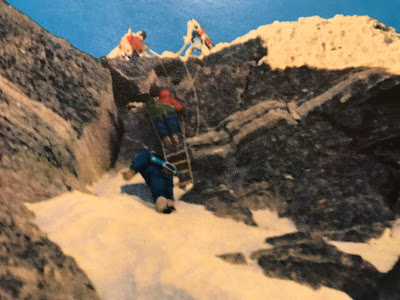… Their remarkable feat in the conquest of nature, the second of its kind accomplished by Chinese mountaineers, was a triumph of Chairman Mao's proletarian revolutionary line, another creditable achievement of the Great Proletarian Cultural Revolution and the movement to criticize Lin Piao and Confucius.
Thus begins Another Ascent of the World’s Highest Peak: Qomolangma, published by Peking’s Foreign Languages Press soon after the event. This was the second Chinese expedition to the mountain that some recidivist elements still call Everest. The first one in 1960 had completed the north ridge route to the summit, as originally prospected by the British expeditions of the 1920s.
The 1975 expedition was notable for the participation of 36 women climbers and support members, of whom one reached the top. This triumph is set out in a carefully worded paragraph:
The fact that during the Chinese expedition, a woman climber reached the summit of Qomolangma from the north side for the first time in world history, serves as a convincing proof of the great truth pointed out by Chairman Mao: "Times have changed, and today men and women are equal. Whatever men comrades can accomplish, women comrades can too."
The summiteer mentioned above was Phantog (right), who was born as “daughter of a serf” in Tibet. When selected for training as a mountaineer – this was in 1959 – she was working for the “July First” State Farm in Lhasa.
Phantog very nearly became the first woman to summit Everest from any side – except that Japan’s Tabei Junko had pipped her to the post just 11 days earlier, reaching the summit via the southern route. But this was a disappointment that the anonymous authors of the Foreign Language Press book could not bring themselves to mention explicitly.
The book’s illustrations reveal much of the motivations that China’s mountaineers were obliged to profess during the last years of Chairman Mao’s tenure. The words in italics are the original English-language photo captions:
Source of strength, guarantee for victory. Earnestly studying Chairman Mao's works they enhance their consciousness of the necessity of continuing the revolution and strengthen their determination to conquer the world's highest peak.
"Never forget bitter class oppression, firmly remember the blood and tears of the down-trodden!" A visit to an exhibition on class education in Lhasa, exposing the brutal oppression of the Tibetan people by the serf-owners, arouses burning hatred for the old society and strong love of the new in the minds of the mountaineers.
Study hard to combat and prevent revisionism and consolidate the dictatorship of the proletariat. Secretary of the Party Committee of the Expedition Wang Fu-chou (second right), one of the three that reached the summit of Qomolangma for the first time ever from the north slope in 1960, and mountaineers at the 6,000-m. camp, study the theory of the dictatorship of the proletariat to fortify their revolutionary will in scaling the world's highest peak.
Nothing can stop the advance of the mountaineering heroes armed with Mao Tsetung Thought. Here, they are seen struggling up a snowy slope at 7,400 m. in the teeth of ferocious altitude winds.
Women alpinists write big-character posters to criticize the reactionary fallacy preached by Lin Piao and Confucius, that "man is superior to woman," and to pledge their determination to win honour for socialist China by a successful climb of Qomolangma.
Instantly Base Camp becomes alive with joy and excitement, shouts of "Long live Chairman Mao!" and "Long live the Chinese Communist Party!" echo through the valleys.
There is a coda to this expedition. Four years after their respective Everest ascents, Phantog met Tabei Junko at a climbers’ meet in Chamonix, where they were photographed together with Poland’s Wanda Rutkiewicz, the third woman to summit Qomolangma. The full story is told by Alison Osius, herself a climber of renown.
Phantog and Tabei were coevals, both born in 1939. Both combined full-time jobs with climbing, marriage and motherhood – Phantog had three children, and Tabei two. Each was a member of her country’s mountaineering elite. One wonders if they had a language in common and, if so, what they talked about at that long-ago encounter in Chamonix …
 |
| Photo by courtesy of Isabelle Agresti/Climbing |
Phantog and Tabei were coevals, both born in 1939. Both combined full-time jobs with climbing, marriage and motherhood – Phantog had three children, and Tabei two. Each was a member of her country’s mountaineering elite. One wonders if they had a language in common and, if so, what they talked about at that long-ago encounter in Chamonix …
References
Another Ascent of the World's Highest Peak: Qomolangma, Foreign Languages Press, Peking, 1975.
Alison Osius, The First Three Women to Climb Everest, Climbing online, March 2021.














No comments:
Post a Comment